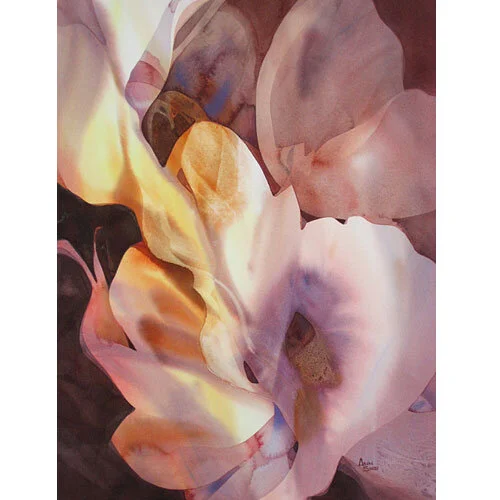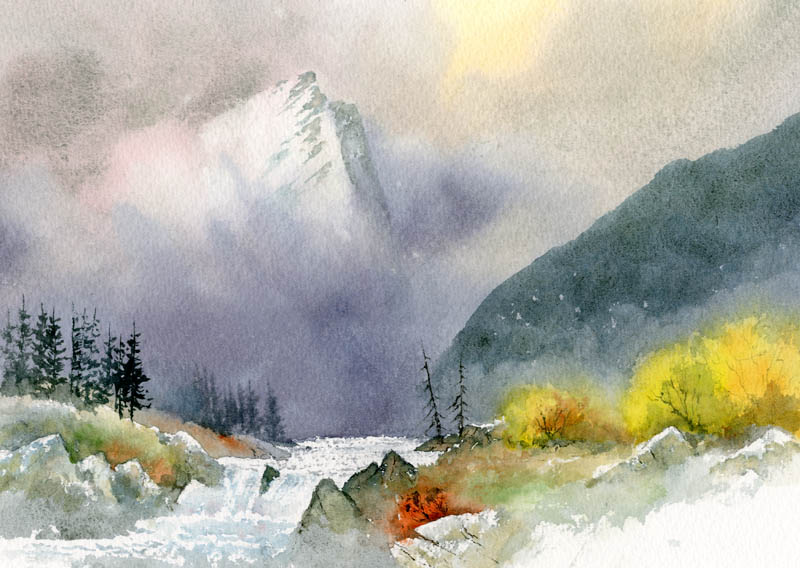Why Watercolor Is So Hard (and why you should embrace it)
Watercolor has the reputation of being difficult. It has been know to cause feelings of frustration, defeat, and disappointment. Especially for those who are just starting out and all they want is to paint something they can be proud of.
In the beginning stages of learning, we usually take it very seriously and put our full concentration into that subject. With painting, this can manifest in the form of control. Control works well with mediums like acrylic - where the paint acts in a predictable way. It goes where you put it and the color you see on your palette is the color you get on your paper. Watercolors don’t act that way, which means that the more you try to control them, the more difficult the experience might feel.
When I was in architecture school, we had a very theory-driven class that challenged the way I thought and forever changed my approach to working with all mediums. I remember there was one project in particular where I was fighting with the material that I chose to build with. During this struggle, the professor asked me if I ever thought about respecting the material and allowing it to perform its natural role using its inherent qualities. When I took a step back and processed what he was telling me, I had this lightbulb moment and everything became easier. I just needed to let it do its thing.
I approach watercolor in this way and I think that it is a big reason why it’s been so enjoyable for me. Recognize the qualities of the medium and approach it with open eyes, embrace what it can do, and work with it instead of trying to control it.
Below, I’m going to go through the reasons why I think watercolor is difficult, but also why each of these are qualities that make this medium so beautiful.
Watercolor is Fluid
Water is hard to control. Water is fluid, it flows and moves in all different directions. Our paints will respond differently when there’s too much water, just enough water, and not enough water. There are so many factors here that can change the outcome of our painting.
But this is also what makes watercolors so unique. You can get hard edges like you’d expect to be able to do, but with watercolors you can also create really soft blends and bleeds from one color to the next. Pretty amazing.
Watercolor is Transparent
Because of the transparent qualities, you can’t really cover up your mistakes. If you make a wrong stroke and the paint dries, you can’t hide it with more paint - unless you paint the area very dark. If you keep layering to try covering up a mistake there’s a danger of “overworking” your painting. Sketch lines, if drawn too dark could show up behind light colors in a watercolor painting, making it tricky if you want to draw or sketch before laying down color.
However, it’s also this transparency of watercolor paints that creates luminosity in paintings. Some paintings look like they almost glow, and can capture the light shining through thin petals and glowing on surfaces.
Watercolor is Permanent
There’s little room for erasing any mistakes in watercolors. You can still lift up color and blot up mistakes with towels, but for the most part, once the paint has dried on paper, the pigments will be soaked up by the paper fibers and that can be scary - but not any more than using a pen when you really think about it.
This quality of staining this is also the reason why watercolors can look do dynamic in our paintings, the way that the paints settle into the paper - darker in some areas, lighters than other is what creates extra interest in watercolor paintings. I happen to love granulating pigments - seeing how they dry and settle into the texture of the paper is such a beautiful look.
No White Paint in Watercolor
White paint isn’t (typically) used for highlights or brights areas. The white areas are where the paper is allowed to show through (or where masking fluid was used). This makes watercolor painting difficult because it requires a little extra planning before jumping into a painting.
I think seeing white or highlights left in watercolor paintings is something that draws you more into them. It creates a sense of curiosity - did the artist leave the white intentionally unpainted, did they use masking fluid first?
Jean Grastorf's uses masking fluid (frisket) to protect the whites of her paper, creating beautiful sunlit images.
Photo Source: www.jeangrastorf.com
Watercolor is Unpredictable
Appearances are not what they seem in watercolor. As mentioned before, watercolors are unpredictable because we’re working with a fluid medium. On top of that, there are two other main qualities that make them elusive.
The first is the paint itself. I touched on this at the beginning of this post: the paint that comes out of the tube is not what we see on paper. We need to work the paint by adding water - and what we see in our palette is not what ends up on the paper.
The second quality is the way it dries. Watercolor paintings will change even after we’re done painting. Paints are darker when they are wet. As paintings dry and the water evaporates, the pigments become lighter and settle in sometimes unexpected ways.
However, this is also what is so interesting about watercolors for me. I can paint something and think it’s going to turn out terribly but after it dries, it’s not as bad as I thought it would be. This also is true the other way around sometimes! Isn’t it fascinating how our own watercolor paintings can shift and surprise us after we’ve already put down the brush?
Embracing the Difficulties of Watercolor
All the reasons watercolors are difficult are all the same reasons that make it elusive, beautiful, and make me want to explore them more. The most fun I have is when I let go, and allow the brush, water, and paint lead the way. It may sound strange, but sometimes letting go and experimenting - even if you end up with a colorful (or muddy) mess are steps towards understanding how to work WITH the paint and letting its natural qualities do their thing. As the saying goes:
“When you try to control everything, you enjoy nothing.”
A beautiful example of the ability to get hard crisp lines and soft blends with watercolors from David Bellamy. Photo Source: www.davidbellamy.co.uk
After posting example images above from watercolor masters, posting any of my own work feels so silly. But seeing their work gives me something to strive for, it is inspiring and makes me want to get my paints out and continue practicing. Below are a few pieces that I painted as exercises and experiments recently. They are by no means masterpieces, but it's ok. These are snapshots of a journey that I'm happy to be on.
I hope that this post was helpful and if you happen to be struggling with watercolors, know that you aren’t alone! It isn’t an easy medium and it can be frustrating. Be kind to yourself, patient with the process, and embrace its qualities. But most importantly, remember to enjoy yourself!
Let me know in the comments below what you think makes watercolors difficult, I’d love to know!
Thanks for reading,
Susan
P.S. If you happen to be the type of person who would enjoy exploring watercolors with more personal guidance from myself alongside a community of friends...I'd love for you to think about joining us inside Paint With Me!
Paint With Me is a membership community all about practicing and making progress in your watercolor painting with good company. Click the button below to learn more and join us inside!







